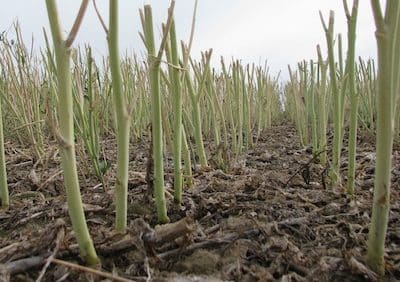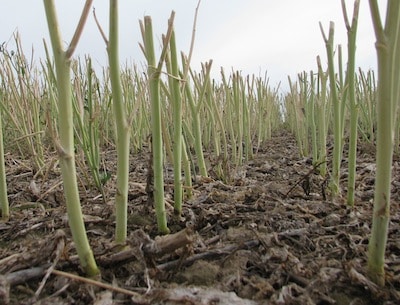Ideal timing for post-harvest jobs varies from right after combining to just before winter. Here is a list of post-harvest field operations and the ideal times to do them.
Plant counts. You can do this anytime. Five canola plants per square foot is generally considered the minimum for canola to reach its yield potential. If the average is lower than five, consider what may have caused this thin stand and plan to make amends, if deemed necessary or possible, to improve stands for next year. If plant counts are a lot lower now than they were after first emergence, what happened and how can this be prevented next year? How to do plant counts.
Post-harvest disease scouting. This should be done as soon as possible. Usually waiting until after combining is too late to accurately identify diseases on stubble and roots. But it might be worth a try. Read more.
Seed purchases. Planning and placing orders tend to start in late summer and stretch through the fall. Before making snap decisions, review the disease resistance and other target traits, then go through the data at canolaperformancetrials.ca. It features independent, third-party trial data on familiar and new canola varieties from both small plot and field scale sites all across western Canada. Data for 2017 is not available yet, but the site has data from 2011 to 2016. Listen to SaskCanola director Lane Stockbrugger talk about the CPTs in this radio interview. Read more on how to use the CPT online tool.
Marketing plan. Good yields in certain areas could mean fewer opportunities to hit off-the-combine delivery targets – if that’s part of your marketing plan. With larger crops and more just-in-time delivery contracts, growers will want to know the quality range bin to bin, storage risk bin to bin and factor that into their marketing plans.
Weed management. Fall is a good time to control perennial and winter annual weeds, but spraying immediately after harvest may not provide the best results. For example, perennial weeds cut off at harvest need time to accumulate new leaf tissue to absorb herbicides. Four weeks is a minimum recommendation and six weeks is ideal. Read more.
Residue management. Good canola stand establishment often relies on effective cereal residue management in the fall. A combine with sharp chopper blades and a spread pattern that matches header width is the most effective residue management tool. More tips.
Soil sampling. For results as close as possible to the situation next spring, the ideal time to take fall samples is when soil temperatures drop below 10°C and as close to freeze-up as possible. Read more.
Fertilizer application. Fall fertilizer is best applied as close to freeze up as possible to balance two objectives: (1) allow soil to seal over the band and (2) reduce losses due to high microbial activity in warm soils. Consider soil moisture: Aapplying NH3 when really dry is probably a bad idea. Read more.
Tillage. Tillage increases the risk of soil erosion and it has the potential to spread clubroot and verticillium. Tillage also dries out already dry fields and cuts down standing stubble that can trap snow. If the primary purpose for tillage is ruts, for example, consider targeted tillage operations to deal with the problem.

